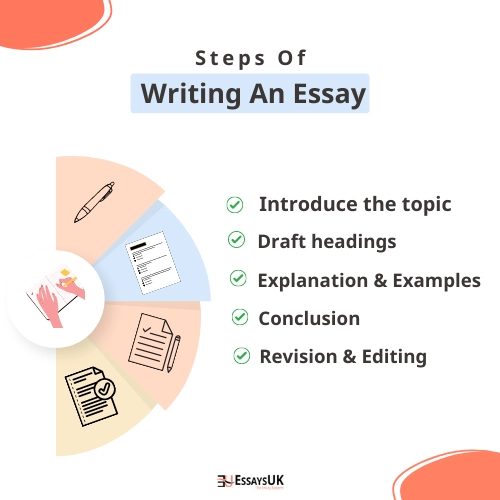How to Write an Essay: A Step-By-Step Guide
Are you looking for a guide on how to write an essay You are certainly in the right place. You will be provided with the complete guidelines required to write an impeccable essay here.

What is an Essay?
An essay is the most popular form of academic writing that presents an argument or narrative through explanation, analysis, and evidence.
An academic essay aims to persuade readers to agree to a certain point of view or a position through informed arguments. An academic essay’s length depends on the academic level, subject of study, and course guidelines. High school essays are much shorter in length when compared to Bachelor’s and Master’s level essays.
Types of Essays
There are many types of essays that you might be asked to write about during your course. The most notable types are descriptive, argumentative, narrative, and expository.
Descriptive Essay
A descriptive essay is a type of essay that expects the writer to describe something. The description could be of anything, from the Earth to an Ant. It promotes writing detailed accounts of a particular experience.
Example:
“Describe a place you go to soothe your mind”
Argumentative Essay
In argumentative essays, you use claims and facts to back your opinion on a particular topic and convince the reader to agree with your opinion.
Example:
“Who is responsible for the abusive language used in the comments on the web?”
Expository Essay
An expository essay is based on an investigation of an idea, and an argument is placed to resolve the idea in a clear and concise manner.
Example:
“Define the main elements of a healthy relationship.”
Narrative Essay
A narrative essay only has a single motif around which the narration revolves. It allows the essayist to colour the picture, from his personal experience, in the form of a short story. A narrative essay helps you create a marvellous piece of art using nothing but your imagination and creativity.
Example:
“The most impactful person in my life.”
A Step-By-Step Guide to Essay Writing
The essay writing process consists of three steps:
- Planning: Conduct desk-based research to find topics that match your requirements. Develop an essay outline on the chosen topic.
- Writing: Provide background to the topic, write the thesis statement or your central argument in the introduction, back your argument with evidence in the main body, and briefly summarise key arguments in the conclusion.
- Proofreading and editing: Proofread the essay to fix mistakes relating to structure, coherence, transitioning, grammar, spelling, and organisation of your essay.
This essay writing guide takes you through an essay’s most important components, including the introduction, main body, and conclusion.
The aforementioned steps of the essay writing process apply to all types of essays regardless of the academic level and subject of study. However, the time and effort required to complete each step depend on the type of essay.
For example, a university-level argumentative essay assignment will require you to spend most of your time researching the topic, developing a central theme, and finding the supporting evidence material to back your argument. On the other hand, you will spend more time on the writing process for a high school expository essay.
| Planning | Writing | Proofreading and editing |
| Conduct research | Write the introduction | Check your work for language mistakes |
| Find a suitable essay topic | Write the paragraphs of the main body | Check the relevancy and accuracy of content in each paragraph. |
| Develop the thesis statement | Summarise the key points in the conclusion | Improve the overall organisation of the essay |
| Write an essay outline | Remove plagiarism if any |
Planning
Planning is an essential aspect of the essay writing process. Before you start writing, make sure you know the question you aim to address and how you will do it. The following topics can help you better prepare for the writing stage.
Carefully read the essay brief: Read the assignment brief to make sure you understand the requirements, such as the deadline and the expected length.
Select a topic:
Most high schools require students to write on a pre-assigned topic. However, if you have the freedom to choose your own topic, make sure your selection aligns with your interests. It will be an uphill challenge to write on a topic that you find boring.
Conduct research:
Explore and read academic sources (both primary and secondary) to decide your position on the topic. These sources will also be used as evidence in the main body of the essay.
Develop the thesis statement:
Write the thesis statement to express the central argument of the essay. The thesis statement should make a claim, directly answering a question.
Write an outline: Develop an essay outline to orchestrate the rough structure of your essay. This makes the writing part convenient and keeps you on the right track.
Introduction of an Essay
The introduction paragraph allows you to grab the attention of the readers. It provides background information about the topic and informs the readers of what the essay will be about.
The introduction typically comprises 10-15% of the total essay word count. Familiarise yourself with the critical objectives of the introduction before starting to write.
The Hook
One of the critical requirements of the introduction paragraph is to be engaging enough to attract the reader’s curiosity. The first sentence of the introduction, also known as the hook, is used to grab the reader’s attention. Use quotes, suspenseful phrases, surprising facts, or bold statements to emphasise the significance of researching the topic.
For example, if we are writing an essay about “Donald Trump’s victory in the 2016 US elections”, then a hook in the opening statement of the essay can be written as below:
“Donald Trump’s victory in the 2016 US election was nothing short of a revolution”.
Background of the Topic
Once you have captured the readers’ interest through a strong and engaging first statement, the next step is to contextualise the background so the reader can understand your argument. This could involve providing facts and statistics, explaining complicated terms, or analysing an important academic paper or debate. Refrain from getting into details at this stage. You will be able to provide an additional explanation in the main body.
Thesis Statement
The last sentence of the introduction chapter comprises the thesis statement, which is the central argument you will present. The thesis statement allows the author to take a focused position on the topic. An example of a thesis statement from the essay “Donald Trump’s victory in 2016 US elections” would be:
Donald Trump died all expectations from the very beginning of his presidential campaign. Significantly few people believed that he could run for an election and win any primaries. But he proved his critics wrong by winning a sweeping victory in the presidential race.
Main Body Paragraphs
This is the portion of the essay where you present your arguments, support them through evidence, and formulate your ideas. Here, you are expected to back your argument by analysing and interpreting the academic sources used.
How long should be the main body text?
Most high school essays follow the standard three-paragraph approach. Undergraduate and Masters’s level essays, on the other hand, are much longer. For example, the body of a graduate-level argumentative essay can comprise 5000-6000 words. Likewise, for an International Baccalaureate Programme extended essay of 4000 words, the body can take up 5-6 pages.
Paragraph Structure
The main body should follow a clear and logical structure. This means that paragraphs are of utmost importance, and each should focus on a specific idea or argument.
Use topic sentences to introduce each paragraph of the body. Each topic sentence expresses the main of the paragraph in which it occurs and forms a transition from the preceding paragraph. Make sure to create a link between sentences with the help of transition words.
Provide quotes, examples, and primary or secondary data as evidence. Make sure to evaluate the evidence material to show how it helped in formulating the central argument of your essay.
Example Paragraph from Essay’s Main Body
The Democrat’s last stand largely rested on Mrs. Clinton’s strength in the Midwest. Those were states that had gone Democrat for decades, based in part on the support of black and working-class white voters. Those working-class white people, particularly ones without a college education – men and women – deserted the party in droves. Rural voters turned out in high numbers, as the Americans who felt overlooked by the establishment and left behind by the coastal elite made their voices heard. While places like Virginia and Colorado held fast, Wisconsin fell – and Mrs. Clinton’s presidential hopes with it. When all is said and done, Mrs. Clinton may end up winning the popular vote on the back of strong support in places like California and New York and closer-than-expected losses in solid-red states like Utah. The Trump wave hit in the places it had to, however. And it hit hard.
The Conclusion of an Essay
This is the essay’s last paragraph, where the writer concludes the composition. The length of the conclusion should generally be 10-15% of the total text. If you want to write a perfect conclusion for your essay, you must be mindful of the following.
- Connect the dots between the points discussed in the main body of the essay.
- Discuss the upshot of your rationalisation. Spell out how it contributes to a new insight.
- Signify the relevance and magnitude of your hypothesis.
- Don’t forget to finish the conclusion with a catchy and noteworthy statement that leaves a strong final impression on the reader.
What not to Include in the Conclusion
To make the conclusion as impressive as possible, always refrain from making the following mistakes;
- Introducing new evidence or arguments.
- Contradicting your previously made points.
- Weakening your point by mentioning other approaches and hypotheses.
- Incorporating concluding phrases like “To summarise”, “Finally”, or “To sum up”.
Now that you are familiar with the guidelines of how to write an essay, you are ready to start writing. Make sure to take your time and research the topic for better results!
Proofreading and editing
- Check your work for language mistakes
- Check the relevancy and accuracy of content in each paragraph.
- Improve the overall organisation of the essay
- Remove plagiarism if any
Essay Checklist
Has a difficult essay got you down? No problem!
With EssaysUK you get:
- Expert UK Writers
- Plagiarism-free Content
- Timely Delivery
- Thorough Research
- Rigorous Quality Control
Frequently Asked Questions
The essays displayed on our websites are not for sale. These are only for sample purposes. Buying or using the same pieces can lead to plagiarism associated issues. We only offer exclusive and custom writing services.
In our online order form, there will be an option to add one or more drafts to your order in the paid/optional feature. Once you have paid for the service, our team will contact you and confirm the delivery date of each draft. The cost of the additional draft will depend on the number of words written by the writer (if any) and the extra hours to be spent on your order. You can contact us within 24 hours after receiving the draft so that we can ensure the timely delivery of your paper.
Paying over the phone isn’t a safe option. You can make the payment on our website using a debit/credit card, PayPal or bank transfer.
Our team of experienced and qualified writers can do all sorts of academic projects regardless of how urgent your requirement is. Orders with short deadlines, especially those with same or next day delivery, require additional charges.




